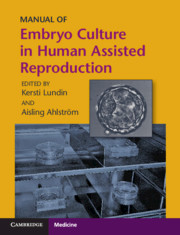Book contents
- Manual of Embryo Culture in Human Assisted Reproduction
- Cambridge Laboratory Manuals in Assisted Reproductive Technology
- Manual of Embryo Culture in Human Assisted Reproduction
- Copyright page
- Contents
- Contributors
- Preface
- Chapter 1 Facilities for Embryo Culture
- Chapter 2 Incubators for Embryo Culture
- Chapter 3 Consumables for the IVF Laboratory
- Chapter 4 Embryo Metabolism and What Does the Embryo Need?
- Chapter 5 Culture Media and Embryo Culture
- Chapter 6 Optimal Handling Techniques for Culture of Human Embryos
- Chapter 7 From Identification to Witnessing
- Chapter 8 Timing of Embryo Culture
- Chapter 9 Time-Lapse Technology
- Chapter 10 Laboratory Monitoring for Embryo Culture
- Chapter 11 Embryo Culture and IVF Offspring Outcome
- Chapter 12 The Changing Culture of Embryo Culture
- Index
- Plate Section (PDF Only)
- References
Chapter 7 - From Identification to Witnessing
Traceability to Ensure the Safety of the Embryo during Culture
Published online by Cambridge University Press: 15 April 2021
- Manual of Embryo Culture in Human Assisted Reproduction
- Cambridge Laboratory Manuals in Assisted Reproductive Technology
- Manual of Embryo Culture in Human Assisted Reproduction
- Copyright page
- Contents
- Contributors
- Preface
- Chapter 1 Facilities for Embryo Culture
- Chapter 2 Incubators for Embryo Culture
- Chapter 3 Consumables for the IVF Laboratory
- Chapter 4 Embryo Metabolism and What Does the Embryo Need?
- Chapter 5 Culture Media and Embryo Culture
- Chapter 6 Optimal Handling Techniques for Culture of Human Embryos
- Chapter 7 From Identification to Witnessing
- Chapter 8 Timing of Embryo Culture
- Chapter 9 Time-Lapse Technology
- Chapter 10 Laboratory Monitoring for Embryo Culture
- Chapter 11 Embryo Culture and IVF Offspring Outcome
- Chapter 12 The Changing Culture of Embryo Culture
- Index
- Plate Section (PDF Only)
- References
Summary
The most important purpose of embryo culture in the IVF lab is to make sure that the embryo can develop to its full potential in a safe and secure environment, and to prevent any errors that can lead to cancellation of the IVF cycle, or risk of other adverse outcomes. In a study by Sakkas et al. (2018),1 including data from over 10 years and more than 35,000 fresh and frozen IVF cycles from more than 180,000 individual laboratory procedures, it was shown that the rate of moderate nonconformances was 0.23%. These failures are described as problems that negatively affect a cycle but not to the extent that the cycle is lost or severely compromised. Although the data from this study is reassuring and shows a very low rate of nonconformance during treatment, the most undesirable and catastrophic event that can occur in an IVF laboratory is a misidentification and mix-up of sperm, egg, or embryo. Embryo culture is a lengthy process that can last up to 6 or even 7 days in which the culture dish is manipulated regularly, sometimes on a daily basis, for purposes such as fertilization, embryo quality assessment, transfer, and cryopreservation. During these manipulations stringent procedures and protocols have to be in place in order to track and trace each and every embryo throughout the embryo culture. The ESHRE guideline for good practice in IVF laboratories includes a section on identification of patients and traceability of their reproductive cells.2 Although traceability is part of the quality management systems in IVF laboratories today, there is not one system that is fail-safe.
- Type
- Chapter
- Information
- Manual of Embryo Culture in Human Assisted Reproduction , pp. 61 - 65Publisher: Cambridge University PressPrint publication year: 2021
References
- 1
- Cited by



